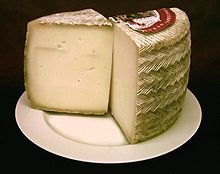Manchego cheese
| Manchego | |
|---|---|
 |
|
| Other names | None |
| Country of origin | Spain |
| Region | La Mancha |
| Source of milk | sheep |
| Texture | Firm and compact |
| Fat content | 6.5% min |
| Protein content | 4.5% min |
| Dimensions | max height 12 cm max diameter 22 cm |
| Weight | min 0.4 kg, max 4.0 kg |
| Aging time | min 60 days, max 2 years |
| Certification | PDO |
Manchego (officially Spanish: queso manchego, pronounced [ˈkeso maɲˈtʃeɣo]) is a cheese made in the La Mancha region of Spain from the milk of sheep of the manchega breed. Official manchego cheese is to be aged for between 60 days and two years.
Manchego has a firm and compact consistency and a buttery texture, and often contains small, unevenly distributed air pockets. The colour of the cheese varies from white to ivory-yellow, and the inedible rind from yellow to brownish-beige. The cheese has a distinctive flavour, well-developed but not too strong, creamy with a slight piquancy, and leaves an aftertaste that is characteristic of sheep's milk.
The designation queso manchego is protected under Spain's Denominación de Origen (DO) regulatory classification system, and the cheese has been granted Protected Designation of Origin (PDO) status by the European Union.
To be designated as queso manchego, the cheese must satisfy the following requirements:
Manchego cheese can be made from pasteurised or raw milk; if the latter, it may be labelled as artesano (artisan). The only permitted additives are natural rennet or another approved coagulating enzyme, and sodium chloride (salt).
The moulds in which the cheese is pressed are barrel-shaped. Traditionally, manchego cheese was made by pressing the curd in plaited esparto grass baskets, which left a distinctive zig-zag pattern (known as pleita) on the rind. Today the same effect is achieved by the mould, the inside of which has a design in relief that imparts to the finished cheese an embossed pattern similar to that of woven esparto grass. The top and bottom surfaces of the cheese are impressed with a design of an ear of wheat.
...
Wikipedia
